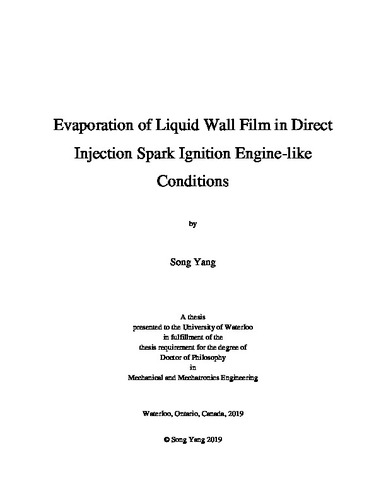| dc.description.abstract | The liquid wall film formed by the spray impingement in Direct Injection Spark Ignition (DISI) engines can directly produce a large amount of Particle Matter (PM) emissions. The PM emissions can be tremendously reduced if all the liquid wall film can evaporate completely before flame propagates to the wall surface and the combustion of ‘pool fire’ fed by the evaporating liquid wall film can be totally eliminated. Evaporation models are widely used to predict the evaporation of liquid wall film in engines, but requiring accurate mass transfer correlations. However, it is challenging to experimentally determine the accurate mass transfer correlations of the liquid wall film in engines; since the evaporation time of the thin liquid wall film in engines is quite short and the thickness of the liquid wall film is extremely thin. Thus, numerical simulation has become a useful tool to provide insight into the underlying transient evaporation characteristics of liquid wall film in DISI engine-like conditions and to derive the mass transfer correlations.
In this thesis research, numerical study has been conducted for a two-dimensional, two-phase, transient, non-isothermal and species transport problem representing the evaporation of liquid wall film in DISI engine-like conditions. The unique features of the numerical models are the inclusion of the transient motion and heating of the liquid phase, the blowing effects caused by evaporation, and the variation of thermo-physical properties. The governing equations which mathematically describe the transient evaporation process of liquid wall film in DISI engines, are discretized and solved using a Finite Volume Method (FVM) based software, Fluent, with its capability of User Defined Function (UDF) programming.
The numerical evaporation models are validated with existing analytical and experimental data; and good agreements are observed. Subsequently, the validated models are used for the numerical study of the evaporating liquid wall film in DISI engine-like conditions to investigate its transient evaporation characteristics and determine its mass transfer correlations. The results show that the evaporation rate of liquid wall film, characterized by mass transfer coefficient, is non-uniform along the wall film, which is consistent with the development of species boundary layer and the decline of species concentration gradient within the boundary layer. The transient evaporation of liquid wall film in DISI engine-like conditions is mainly determined by the gas/liquid interfacial temperature, which can be directly affected by the transient heating of the liquid phase. The newly developed mass transfer correlations taking into account the blowing effects and effects caused by convection and the variation of thermo-physical properties during the transient evaporation process of the liquid wall film can predict their evaporation rate much more accurately than the existing correlations available in literature. | en |

